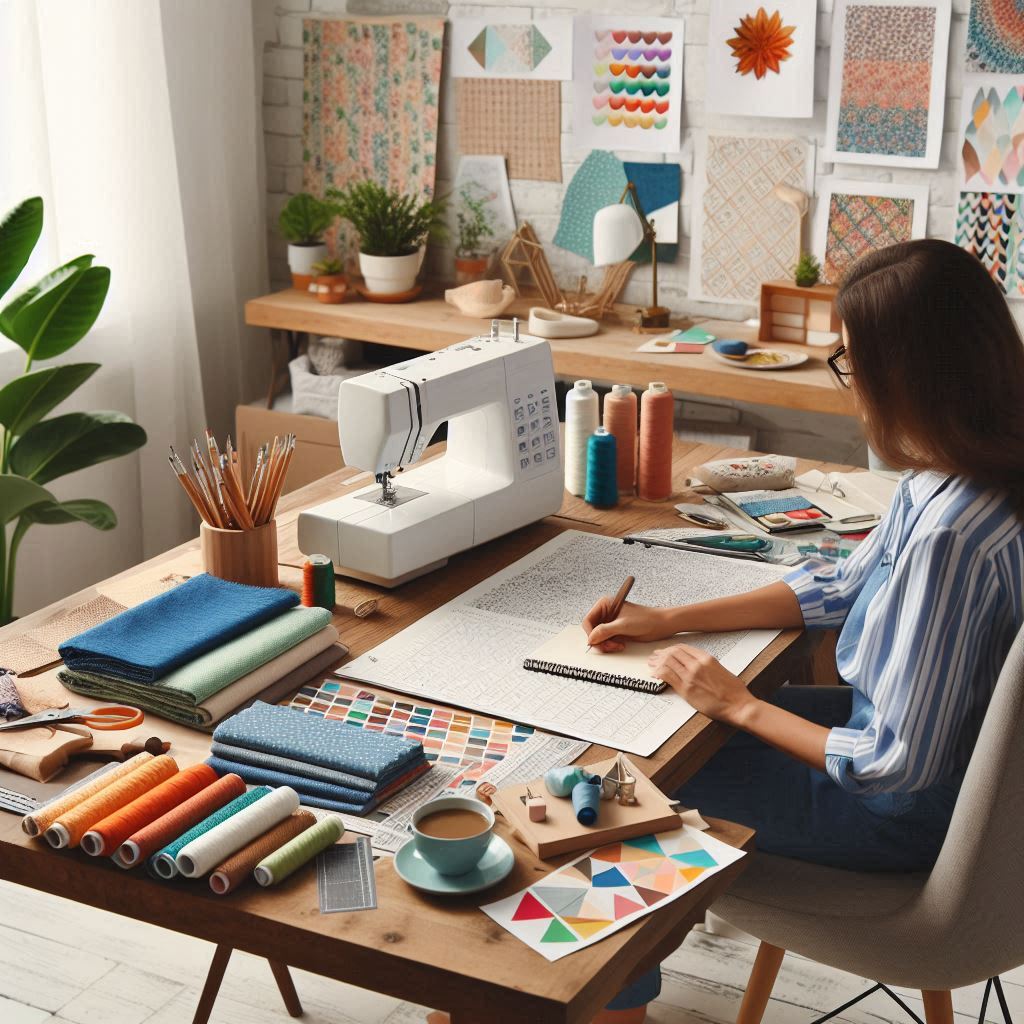Introduction
Textile design is the art and science of creating fabric patterns, textures, and colors for various applications, ranging from fashion to interior d‘cor.
This multifaceted discipline combines creativity with technical expertise, resulting in textiles that serve both functional and aesthetic purposes.
The process of textile design involves a deep understanding of materials, weaving techniques, dyeing methods, and market trends.
Designers use these elements to develop innovative fabrics that not only enhance the visual appeal of a product but also ensure its practicality and durability.
In the fashion industry, textile designers play a pivotal role in bringing clothing and accessories to life.
Their unique designs are fundamental to the overall look and feel of a collection.
By creating innovative and captivating fabrics, they help brands establish their identity and distinguish themselves in a competitive market.
Textile designers influence trends and consumer preferences, shaping the way we perceive and interact with fashion.
They also contribute to sustainability initiatives by developing eco-friendly textiles that meet the growing demand for responsible fashion.
Early Influential Textile Designers
Pioneers in the Field of Textile Design
The textile design field boasts numerous pioneers who shaped its development.
These early designers introduced innovative techniques and styles, leaving a lasting impact on the industry.
Their work continues to inspire contemporary designers today.
Their Contributions to the Industry
William Morris stands out as a key figure in textile design.
He founded the Arts and Crafts Movement in the late 19th century.
Morris emphasized craftsmanship and quality, opposing mass production.
He believed in creating beautiful, functional items.
His textiles featured intricate patterns drawn from nature.
Morris’s designs often incorporated floral motifs and organic forms.
This connection to nature became a hallmark of his work.
His textile patterns, like “Strawberry Thief,” remain popular today.
They capture the beauty and complexity of the natural world.
Another significant figure is Marianne Straub, a Scottish textile designer.
Straub‘s work in the mid-20th century introduced fresh perspectives on fabric design.
She focused on combining color, texture, and pattern harmoniously.
Her innovative techniques pushed the boundaries of traditional textile design.
Straub’s approach incorporated both handwoven and machine-made fabrics.
This blending of methods allowed her to explore new design possibilities.
Straub also championed the importance of textiles in everyday life.
She believed that textiles could enhance living spaces.
Her designs often reflected the modernist movement, emphasizing simplicity and functionality.
Straub’s commitment to education also left a profound impact.
She taught at various institutions, nurturing future generations of designers.
Her influence extends beyond her own creations, shaping the way textiles are viewed today.
Notable Names Like William Morris and Marianne Straub
In addition to Morris and Straub, other pioneers made notable contributions.
Anni Albers, a Bauhaus student, revolutionized textile design in the 20th century.
Her work emphasized the artistic aspects of textiles, merging fine art and craft.
Albers‘s innovative techniques, such as weaving, challenged conventional ideas.
She elevated textiles to an art form, showcasing their potential for expression.
Similarly, Lucienne Day played a vital role in modern textile design.
Her bold, abstract patterns gained popularity in the post-war era.
Day‘s work reflected a shift toward vibrant colors and geometric shapes.
She brought a sense of optimism and energy to textiles.
Her designs often adorned furniture and interiors, influencing design trends.
These early influential textile designers laid the groundwork for the industry.
Their dedication to craftsmanship and innovative techniques reshaped the textile landscape.
The legacies of Morris, Straub, Albers, and Day continue to inspire new generations.
As we appreciate contemporary textile design, we must recognize these pioneers.
Their contributions helped define the rich history of textile artistry.
Understanding their impact allows us to appreciate textiles as both functional and beautiful art forms.
Contemporary Textile Designers
Current Designers Making Waves in the Industry
The textile design industry today thrives with innovative talent pushing boundaries.
Contemporary designers are redefining aesthetics and functionality through their unique approaches.
These creators embrace sustainability, technology, and artistic expression, reshaping the landscape of textile design.
Their Unique Styles and Techniques
Jack Lenor Larsen is a prominent figure in contemporary textile design.
His work focuses on weaving, blending traditional techniques with modern aesthetics.
Larsen’s textiles often showcase rich textures and vibrant colors.
He emphasizes the importance of craftsmanship, producing handwoven fabrics that celebrate artistry.
His collections reflect a deep respect for nature and cultural influences.
Through his designs, Larsen explores the interplay between art and function, creating textiles that elevate spaces.
Zandra Rhodes, another influential designer, is known for her bold and imaginative style.
She revolutionized textile design in the fashion industry with her distinctive prints and patterns.
Rhodes’s work often features vibrant colors and dramatic motifs, capturing attention and sparking conversation.
Her innovative use of textiles in fashion has set trends and inspired other designers.
Rhodes’s approach combines artistic vision with a keen understanding of textile technology, resulting in striking designs that stand out.
Names Like Jack Lenor Larsen and Zandra Rhodes
Both Jack Lenor Larsen and Zandra Rhodes exemplify the spirit of contemporary textile design.
Larsen‘s commitment to craftsmanship and artistic integrity creates timeless pieces that resonate with collectors.
His works are featured in prestigious institutions, celebrating the fusion of tradition and modernity.
Meanwhile, Rhodes continues to challenge conventions, making a significant impact in both fashion and textile design.
In addition to these two designers, several others contribute to the vibrant textile landscape.
Designers like Anna Maria Horner and Marimekko are also making waves.
Horner‘s work combines quilting, fashion, and home decor, showcasing a playful use of color.
Marimekko, a Finnish brand, is renowned for its bold prints and sustainable practices, influencing global design trends.
Contemporary textile designers are not just creators; they are storytellers.
Their designs often reflect personal narratives, cultural heritage, and contemporary issues.
By exploring diverse themes, they create textiles that resonate with a global audience.
As the industry evolves, these designers remain at the forefront, continuously shaping the future of textile design.
In short, contemporary textile designers like Jack Lenor Larsen and Zandra Rhodes play pivotal roles in transforming the industry.
Their unique styles and innovative techniques highlight the diversity and creativity within textile design.
As we celebrate their contributions, we must acknowledge the broader community of designers pushing the limits of this dynamic field.
Through their artistry, they inspire future generations to explore the endless possibilities of textiles.
Read: Building a Portfolio for Costume Design
Impact of Textile Designers on Fashion
How Textile Designers Influence Fashion Trends
Textile designers play a crucial role in shaping fashion trends.
Their creativity and innovation directly influence the materials and patterns that dominate the runway.
By experimenting with colors, textures, and techniques, textile designers set the tone for seasonal collections.
Their unique fabric creations inspire fashion designers to develop new silhouettes and styles.
This symbiotic relationship between textile and fashion design fosters a dynamic industry where trends evolve continuously.
Collaborations Between Designers and Fashion Houses
Collaborations between textile designers and fashion houses often yield exciting results.
When these two creative forces unite, they bring fresh perspectives and ideas.
For example, renowned textile designer Jack Lenor Larsen collaborated with various fashion brands to create stunning collections.
His handwoven fabrics enhanced the visual appeal of garments, showcasing the beauty of textiles in fashion.
Zandra Rhodes is another prime example of successful collaboration.
Her bold prints have been featured in numerous fashion collections, transforming how textiles are perceived in haute couture.
By working alongside fashion designers, Rhodes helps elevate fabric design to an art form, enriching the overall aesthetic of clothing.
These partnerships not only highlight the importance of textiles but also inspire new trends and innovations.
The Importance of Textiles in the Fashion Industry
Textiles are fundamental to the fashion industry, serving as the foundation for every garment.
The choice of fabric can significantly impact the drape, comfort, and overall look of a piece.
Fashion designers rely on textile designers to provide unique materials that enhance their creative vision.
Quality textiles can elevate a design from ordinary to extraordinary, making them essential in fashion.
Furthermore, textiles contribute to sustainability efforts within the industry.
As consumers increasingly demand eco-friendly options, textile designers are responding by developing sustainable materials.
Innovations like organic cotton, recycled fabrics, and biodegradable textiles are gaining popularity.
These advancements not only address environmental concerns but also influence fashion trends toward more responsible choices.
In addition to their functional roles, textiles also carry cultural significance.
Patterns and materials can reflect cultural identities and traditions, offering a rich narrative within fashion.
Designers often draw inspiration from diverse cultures, incorporating traditional textiles into contemporary designs.
This fusion celebrates heritage while creating a modern aesthetic.
Textile designers significantly impact fashion trends through their creativity and collaboration with fashion houses.
Their innovative fabrics and designs shape the industry, influencing everything from casual wear to haute couture.
As textiles continue to play a vital role in fashion, their importance in shaping trends and fostering sustainability cannot be overstated.
The relationship between textiles and fashion will continue to evolve, driven by the passion and vision of talented designers.
Read: Networking Events for Costume Designers
Textile Designers in Home Decor
How Designers Impact Interior Design Trends
Textile designers significantly influence interior design trends by creating innovative fabrics and patterns.
Their work transforms spaces, making them more inviting and aesthetically pleasing.
As trends evolve, textile designers introduce fresh ideas that inspire interior decorators and homeowners alike.
The use of unique textiles can redefine the character of a room, setting the mood and enhancing the overall design.
Use of Textiles in Home Decor
Textiles are essential in home decor, serving both functional and decorative purposes.
Fabrics can soften hard surfaces, add warmth, and introduce color and texture to a space.
From curtains and upholstery to rugs and cushions, textiles contribute to the overall atmosphere of a room.
Designers use textiles to create focal points, enhance comfort, and reflect individual styles.
The careful selection of fabrics can transform a simple space into a stylish sanctuary.
For instance, layering different textiles can create visual interest and depth.
Mixing patterns, textures, and colors allows for a personalized touch that reflects the homeowner’s taste.
Additionally, sustainable textiles are gaining traction in home decor, as consumers seek eco-friendly options.
Designers are responding with organic fabrics and recycled materials that align with modern values.
Examples of Designers Known for Their Work in This Area
Several textile designers are renowned for their contributions to home decor.
One notable name is Kelly Wearstler, an American designer celebrated for her bold and eclectic style.
Wearstler‘s textiles often feature striking patterns and textures, elevating interior spaces.
Her designs can be seen in luxury hotels, residences, and commercial spaces, making a significant impact on contemporary interior design.
Another influential designer is Thomas Paul, known for his vibrant and whimsical textile patterns.
His work often incorporates nature-inspired motifs, adding a playful touch to home decor.
Paul‘s fabrics can be found in various applications, from throw pillows to wall coverings, enhancing spaces with color and personality.
Additionally, the British designer Cath Kidston is recognized for her charming floral patterns and vintage-inspired textiles.
Kidston‘s designs evoke a sense of nostalgia, making them popular choices for home decor.
Her fabrics are used in various products, including curtains, cushions, and upholstery, creating a warm and inviting atmosphere.
Textile designers play a vital role in shaping interior design trends through their innovative fabrics and patterns.
Their work enhances the functionality and aesthetics of home decor, making spaces more enjoyable and personalized.
Designers like Kelly Wearstler, Thomas Paul, and Cath Kidston exemplify the impact textiles have on interior design.
As the industry evolves, the influence of textile designers will continue to shape the way we create and experience our living spaces.
Read: Freelance vs. In-House Costume Design Jobs

Sustainable Textile Designers
The Importance of Sustainability in Textile Design
Sustainability has become a critical focus in textile design due to environmental concerns.
The fashion and home decor industries have long been associated with waste and pollution.
As consumers grow more conscious of their environmental impact, the demand for sustainable textiles increases.
Designers are now exploring eco-friendly practices, aiming to reduce waste, conserve resources, and promote ethical manufacturing.
Sustainable textile design encompasses various aspects, including material sourcing, production methods, and lifecycle considerations.
By using renewable resources and minimizing environmental harm, designers can create fabrics that not only look good but also feel good.
This shift toward sustainability is reshaping consumer preferences, encouraging a culture of conscious consumption.
Designers Who Prioritize Eco-Friendly Practices
Many designers are leading the charge toward sustainable practices in textile design.
One notable example is Stella McCartney, a pioneer in eco-friendly fashion.
She prioritizes sustainable materials like organic cotton, recycled polyester, and innovative vegan leathers.
McCartney‘s commitment to sustainability extends to her entire brand, promoting responsible practices throughout the supply chain.
Another influential designer is Eileen Fisher, known for her sustainable fashion initiatives.
Fisher’s brand focuses on creating timeless pieces using organic and renewable materials.
She emphasizes ethical labor practices and offers a take-back program, encouraging consumers to recycle their old garments.
Fisher’s dedication to sustainability has positioned her as a leader in the movement toward responsible fashion.
Additionally, the designer Christy Dawn is making waves with her commitment to sustainable textiles.
Her brand utilizes deadstock fabric, reducing waste while creating beautiful clothing.
Dawn’s designs are rooted in timeless aesthetics, emphasizing quality over quantity.
By focusing on sustainable materials and practices, she is changing how consumers view fashion and textiles.
Information on How These Designers Are Changing the Industry
These sustainable textile designers are changing the industry by setting new standards for eco-friendly practices.
They challenge the fast fashion model, encouraging consumers to value quality and sustainability over quantity.
By incorporating innovative materials and ethical manufacturing processes, they inspire other designers to follow suit.
Furthermore, these designers are raising awareness about the environmental impact of textile production.
Their advocacy efforts highlight the need for transparency in the supply chain.
By educating consumers about sustainable choices, they empower individuals to make informed decisions.
The rise of sustainable textile design also encourages collaboration within the industry.
Designers are partnering with textile manufacturers, researchers, and environmental organizations to develop innovative solutions.
This collaborative approach fosters a culture of sustainability that transcends individual brands.
Sustainable textile designers are reshaping the industry by prioritizing eco-friendly practices and materials.
Leaders like Stella McCartney, Eileen Fisher, and Christy Dawn exemplify the positive impact of sustainability in textile design.
As they challenge traditional practices, these designers inspire a movement toward responsible consumption and production.
Their efforts highlight the importance of sustainability in creating a more ethical and environmentally conscious textile industry.
Read: Historic Costume Design Inspirations
Transform Your Career Today
Unlock a personalized career strategy that drives real results. Get tailored advice and a roadmap designed just for you.
Start NowExplore Further: Collaborating with Other Artists in Design
Textile Designers in Different Cultures
How Different Cultures Influence Textile Design
Textile design is deeply influenced by cultural heritage and traditions.
Various cultures bring unique perspectives, techniques, and motifs that enrich the textile landscape.
The use of color, pattern, and material often reflects the history, values, and beliefs of a culture.
As a result, textiles serve not only as functional items but also as expressions of identity and storytelling.
For example, traditional Japanese textiles often emphasize simplicity and natural materials, reflecting the country’s aesthetic philosophy.
Patterns like kasuri and shibori showcase intricate dyeing techniques that tell stories of nature and daily life.
Similarly, Indian textiles, such as block-printed fabrics and ikat, reveal rich histories and regional identities.
The vibrant colors and complex patterns are a testament to India‘s diverse cultural heritage.
Designers from Around the World
Many designers draw inspiration from their cultural backgrounds, creating textiles that celebrate their roots.
One prominent designer is Haji Noor Deen, a master of Arabic calligraphy.
His work integrates traditional Islamic art into contemporary textile design, showcasing the beauty of calligraphy through fabric.
Deen’s designs not only highlight his cultural heritage but also serve as a bridge between art and textile design.
In Africa, designer Tamsin Lejeune focuses on sustainable practices while celebrating African textiles.
Her brand collaborates with artisans to create unique fabrics that incorporate traditional techniques and modern aesthetics.
Lejeune‘s commitment to ethical sourcing and community empowerment exemplifies the impact of cultural collaboration in textile design.
Additionally, Mexican designer Carla Fern‘ndez is known for her work that honors indigenous textiles and craftsmanship.
She incorporates traditional techniques into modern fashion, creating vibrant pieces that celebrate her heritage.
Fern‘ndez‘s designs highlight the importance of preserving cultural practices while promoting sustainability and ethical fashion.
The Diversity and Creativity in Textile Design
The diversity of textile design around the world showcases the incredible creativity of designers.
From the intricate weavings of Peruvian artisans to the bold prints of African textiles, each region contributes unique elements to the global textile narrative.
This diversity fosters innovation, as designers experiment with combining techniques from different cultures.
Furthermore, the rise of globalization has allowed designers to share their cultural influences with a broader audience.
Collaborations between artists from different backgrounds lead to innovative designs that celebrate cultural fusion.
For instance, the integration of traditional Japanese motifs into Western fashion highlights how cultures can inspire and enrich one another.
Textile designers from different cultures significantly influence the textile design landscape.
Their unique perspectives and techniques celebrate cultural heritage and foster creativity.
Designers like Haji Noor Deen, Tamsin Lejeune, and Carla Fern‘ndez exemplify the richness of global textile design.
As we explore these diverse influences, we appreciate the profound connection between culture and textile design, which continues to inspire and innovate in the industry.
Uncover the Details: Top 8 Software Tools for Industrial Designers
Emerging Textile Designers to Watch
Up-and-Coming Designers in the Industry
The textile design industry is constantly evolving, with new talent emerging regularly.
Several up-and-coming designers are making waves, bringing fresh ideas and perspectives.
One such designer is Rachael O‘Neill, known for her playful use of color and pattern.
O‘Neill‘s designs often blend traditional techniques with contemporary aesthetics, creating vibrant textiles that capture attention.
Another noteworthy name is Michaela Sachenbacher, whose work focuses on sustainability and innovative materials.
Sachenbacher‘s textiles incorporate recycled materials, highlighting the importance of eco-friendly practices in the industry.
Her commitment to sustainability and unique design approach make her a designer to watch.
Elisa Vicedo is also gaining recognition for her exploration of cultural motifs and techniques.
Vicedo combines her background in art and design to create textiles that reflect her multicultural influences.
Her work celebrates diversity while showcasing her artistic vision.
Their Unique Perspectives and Styles
These emerging designers bring unique perspectives and styles that set them apart in the textile design landscape.
Rachael O‘Neill‘s whimsical approach often draws inspiration from nature and childhood memories.
Her ability to evoke emotions through color and pattern makes her textiles feel alive and engaging.
Michaela Sachenbacher‘s commitment to sustainability adds a crucial dimension to her work.
By utilizing recycled materials and environmentally friendly practices, she challenges conventional notions of textile design.
Her designs not only look good but also contribute to a more sustainable future.
Elisa Vicedo‘s multicultural background informs her creative process, allowing her to blend various techniques and aesthetics.
She experiments with different textile methods, resulting in unique pieces that reflect her artistic journey.
Vicedo‘s work serves as a reminder of the beauty found in cultural diversity.
Information on How to Support and Follow These Designers
Supporting emerging textile designers is essential for fostering creativity and innovation in the industry.
One way to support these designers is by purchasing their products directly from their websites or through artisan markets.
This not only helps them financially but also allows consumers to own unique pieces that tell a story.
Following these designers on social media platforms is another effective way to stay updated on their work.
Many emerging designers use platforms like Instagram to showcase their latest creations and behind-the-scenes processes.
Engaging with their content by liking, sharing, or commenting can significantly boost their visibility.
Attending local craft fairs, textile exhibitions, and design markets can also provide opportunities to connect with these designers in person.
Many emerging talents showcase their work at such events, allowing consumers to engage with their stories and vision directly.
The textile design industry is enriched by the presence of emerging designers like Rachael O‘Neill, Michaela Sachenbacher, and Elisa Vicedo.
Their unique perspectives and styles bring fresh energy to the field.
By supporting and following these designers, consumers can contribute to a more vibrant and innovative textile design landscape.
As these talents continue to grow and evolve, they will undoubtedly shape the future of textile design.
Conclusion
Textile designers play a crucial role in the fashion and interior design industries.
They bring creativity and innovation to fabric and pattern development, making their contributions invaluable.
Their work influences trends, shapes consumer choices, and often reflects cultural narratives.
By exploring their designs, we gain a deeper appreciation for their craft and the skills involved.
Supporting textile designers fosters growth within the industry.
It encourages emerging talent to share their unique perspectives, helping diversify the creative landscape.
The world of textile design is rich with diversity and inspiration, offering endless possibilities for expression.
Each fabric tells a story and carries cultural significance, connecting us to various traditions.
Engaging with these designers broadens our understanding of art and functionality in everyday life.
As consumers, we can celebrate their contributions through our choices.
Let‘s embrace the creativity and innovation textile designers offer, supporting their work in both commercial and artistic settings.
By doing so, we help sustain a vibrant and evolving industry.
Explore their work, attend exhibitions, and invest in their creations.
This not only enriches your personal style but also honors the artists behind the textiles.
In a world filled with mass-produced items, valuing handcrafted designs leads to a more sustainable future.
So, take the time to discover the remarkable talents in textile design, and let their artistry inspire your own sense of style and creativity.
[E-Books for Sale]
The Big Book of 500 High-Paying Jobs in America: Unlock Your Earning Potential
$19.99 • 500 High-Paying Jobs • 330 pages
Explore 500 high-paying jobs in America and learn how to boost your career, earn more, and achieve success!
See All 500 High-Paying Jobs of this E-Book
1001 Professions Without a Degree: High-Paying American Jobs You Can Start Now
$19.99 • 1001 Professions Without a Degree • 174 pages
Discover 1001 high-paying jobs without a degree! Unlock career tips, skills, and success strategies for just $19.99!




